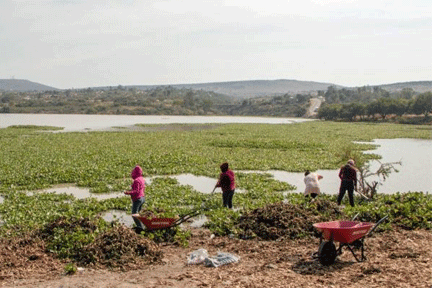A Citizen’s Plan to Rescue the Allende Dam
News Category: News and Community News
-
by Libera Lang
Numbers speak. The surface of the Allende dam is larger than the urban area of San Miguel with a perimeter of 66 kilometers. The water lily infestation is the size of the city and 20% more. It covers 74% of the water surface, equivalent to 3,333 trailers of 45 tons each.
Twenty years ago, there were lily infestations but the causes were never addressed. There was no environmental, social, political, or technical vision to assume responsible management of human, domestic, or industrial waste. Allowing waste water to flow into the Allende dam throughout these years was always the easiest way out. Today, it is the most lethal.
In recent days, José Arturo Morales Tirado has launched a call to the public to recover the Allende dam. He did it based on his technical knowledge. In the past, Morales Tirado was director of Environment and Ecology for the municipality, and he knows the internal processes to exert pressure on difficult issues that require legal intervention. When dealing with the contamination of the dam, where the main cause of the infestation is the water lily, he says, “We would have more control over sewage dumps and the ability to sue under the law.»
From La Casona via Zoom, he communicated his intention to create five work teams made up of individual volunteers and civil organizations. Each group would be led by committed volunteers. He made it clear that «this call has nothing political» and his interest is not to lead a movement. This is a call for collective civil work where groups as well as communities and neighbors participate.
Given the complexity of the problem, the five groups made up of volunteers would have the following functions:
Management of the project. There is room here for all individuals who want to collaborate according to their backgrounds. The group would be in charge of requesting the participation of municipal, state, and federal authorities through written communications. «This is important since they are constitutionally obliged to get involved and it is important to formalize said collaboration,» Morales Tirado stated.
The second group would be in charge of the treasury. The Rotary Club has agreed to handle the accounts for greater transparency. The third group would manage monetary resources and finances and devise a plan to obtain funds. The International Rotary Club would be contacted to receive donations from abroad. The fourth group would deal with the organization of volunteers with boats, materials, and equipment for the control and elimination of the lilies. The fifth would be in charge of the links with society and the media. They would report on the advances or setbacks of the citizen plan.
The integral solution to the problem of the dam is in the short, medium, and long term with 2035 as the limit for the total elimination of sewage. However, Morales Tirado is focusing on immediate action. The first thing, he said, is «to control the dispersal of the lilies through mechanical measures.» Plastic ropes floating with buoys or other means would be used to compact the lilies on the banks. «The dam would be divided into 25 sectors to prevent the lilies from sailing freely.»
Once the water goes down, tractors would be used to crush the lilies. Since the land granted for agriculture is precisely where the lilies would be concentrated, the same tractors that are used for planting would serve to crush the lilies and integrate them into the soil. “We have located many farmers and we just need to synchronize the action once the waters go down. If Conagua informs us when the floodgates open and how much the water levels are going to drop we will be prepared to act when the lilies are trapped on the surface.”
He commented that there are alternative uses of the lilies. They can be of enormous benefit for the restoration and improvement of soils, the production of biogas and others, but will not solve the immediate problem which is the monumental infestation of the lily. “It would take up to 17 years to extract it all manually from the water.”
The next action would be to gradually reduce the contamination of the water until it is completely eliminated. Among the participants was Ricardo Vidargas, from the “Rescatando la Presa Allende” group, who claimed, as did the group’s scientific advisors, that the real problem is not so much removing the lilies but rather cleaning the water. «We, the residents of San Miguel, are the ones who have polluted the dam, at the same time water laws are not applied or complied with.”
At the next meeting on Tuesday, May 16, Morales Tirado said that strategies and solutions will be refined. You may contact Morales Tirado at: fronteratierraadentro.org/turismo-sostenible/
-


Leave a Reply